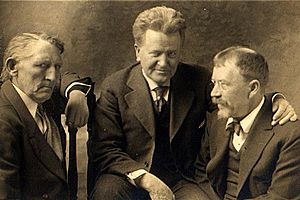International Seamen's Union facts for kids
| Merged into | Seafarer's International Union |
|---|---|
| Founded | 1892 |
| Dissolved | August 1937 |
| Location | |
|
Members
|
115,000 (1919) |
The International Seamen's Union (ISU) was an important American group for sailors. It was a trade union, which is like a club for workers. This union helped sailors get better pay and working conditions. The ISU was active from 1892 until 1937.
Towards the end, the ISU split into two new unions. These were the National Maritime Union and the Seafarer's International Union.
Contents
How the ISU Started
The union began in 1892 in Chicago, Illinois. It was first called the National Union of Seamen of America. It was a group of smaller, independent unions working together. Some of these included the Sailors' Union of the Pacific and the Lake Seamen's Union.
Sailors from the Pacific, Great Lakes, and Gulf Coast areas joined forces. In 1893, the ISU became part of the American Federation of Labor. By 1895, it changed its name to the International Seamen's Union of America.
The time the ISU existed was busy for the United States shipping industry. The union faced many changes in its leaders and members. They also went through big historical events like the Great Depression and World War I.
During World War I, shipping was very busy. The ISU's membership grew to over 115,000 sailors. But when the war ended, membership dropped to 50,000.
Key Achievements and Challenges
The ISU made a big difference in the shipping world. One of its most important successes was helping to pass the Seamen's Act of 1915. This law greatly improved life for American sailors. Here are some of the changes it brought:
- Sailors could no longer be put in prison for leaving their ship.
- Punishments for not obeying orders were made less harsh.
- It set rules for how many hours sailors could work at sea and in port.
- It made sure ships provided good quality food.
- It regulated how sailors' wages were paid.
- It required specific safety measures, like having enough lifeboats.
- A certain number of sailors on a ship had to be qualified Able Seamen.
- At least 75 percent of the sailors on a ship had to understand the language spoken by the officers.
Another win for the ISU was a strike in 1919. This strike led to the highest wages ever for deep-sea sailors during peacetime.
However, the ISU also had tough times. In 1921, they called a strike that failed. This led to a 25 percent cut in sailors' wages. The union was also seen as too old-fashioned by some. In 1934, the Sailors' Union of the Pacific left the ISU. This happened because the ISU felt they were working with "radicals" and ended their membership.
The ISU was also involved in the West Coast longshoremen's strike of 1934. This strike lasted 83 days and helped all West Coast ports become unionized. This strike, along with others in 1934, helped create more industrial unions in the 1930s.
During the strike, West Coast sailors left their ships to support the International Longshoremen's Association. This left over 50 ships empty in San Francisco harbor. ISU leaders supported this strike, even if they were hesitant at first. There were clashes with police, and some people were hurt or killed. After talks to end the strike, sailors got better pay and living conditions. They also got a new system for work shifts.
In 1935, maritime unions met in Seattle. They formed a larger union called the Maritime Federation. Harry Lundeberg became its first president.
The Rise of the National Maritime Union
In 1936, a sailor named Joseph Curran became well-known. He led a strike on the ship S.S. California in San Pedro, California. Sailors on the East Coast also went on strike to support the S.S. California's crew. Curran became a leader of this 10-week strike.
In October 1936, Curran called another strike. This was the 1936 Gulf Coast maritime workers' strike. It aimed to improve working conditions and challenge the ISU. This four-month strike stopped 50,000 sailors and 300 ships along the Atlantic and Gulf coasts.
Curran believed it was time to leave the old-fashioned ISU. He started asking sailors to join a new union. Many ships were delayed because sailors were listening to organizers and signing up for the new union. The ISU's newspaper, The Seamen's Journal, thought Curran's sudden dislike for the ISU was strange. They noted he had only been a member for one year.
In May 1937, Curran and his group formed the National Maritime Union (NMU). In July, they held their first meeting. About 30,000 sailors left the ISU to join the NMU. Curran was elected president of the new union. Within a year, the NMU had over 50,000 members. Most American shipping companies then had contracts with the NMU.
Reorganized as the SIU
In August 1937, William Green, the president of the American Federation of Labor, took charge of the ISU. He wanted to rebuild it. He gave this job to Harry Lundeberg, who also led the Sailor's Union of the Pacific.
On October 15, 1938, at a meeting in Houston, Texas, Green gave Lundeberg the official document for the Seafarer's International Union (SIU). The new union had 7,000 members on the East and Gulf coasts. Today, the SIU still holds the official documents for both the NMU and SUP.
Presidents of the ISU
- Charles Hagen (1892-????)
- Andrew Furuseth (1897–1899)
- Andrew Furuseth (1908–1938)


